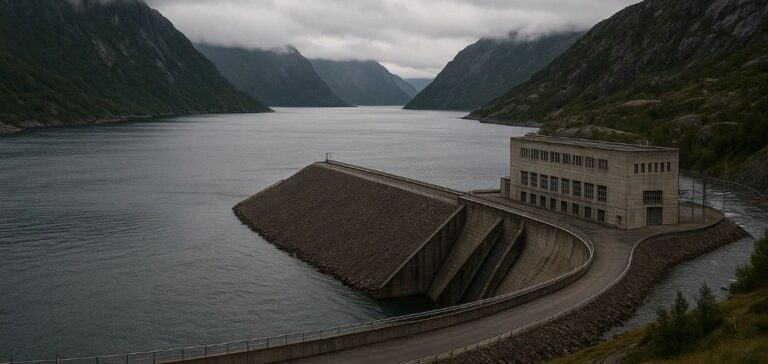The electricity market in Europe faces growing instability, exacerbated by the increasing share of renewable energies, particularly wind and solar. While these energy sources are essential to meet climate goals, they present significant challenges for the management of the European energy grid. Their intermittency, characterized by production peaks outside of high-demand periods, leads to instances where electricity prices turn negative. This phenomenon, which has intensified in recent years, directly impacts the profitability of energy producers and raises concerns about the economic balance of the sector. In this context, Norway, with its vast hydropower storage resources, could play a strategic role in stabilizing the European electricity market.
Hydropower Pumped Storage: A Natural Solution
Norway holds a unique geographical advantage: its deep fjords and natural reservoirs enable the storage of large quantities of surplus energy. These reservoirs provide an estimated storage capacity of 83.2 TWh, spread across major sites such as Skjerstadfjord (25 TWh), Mjøsa (17.6 TWh), and Sandsfjorden (8.1 TWh). Pumped storage, already a well-established technology in Norway, relies on the use of high-altitude reservoirs to store water during periods of energy production surplus. The water is pumped to these reservoirs during times of low demand or excess production, then released to generate electricity when demand increases. This flexible storage capacity is a major asset for regulating Europe’s energy supply and compensating for the intermittency of renewable energy.
Managing Energy Surpluses with Flexible Storage
In Europe, renewable energy production peaks often occur during periods of low demand, such as mid-afternoon on sunny days or during high wind conditions. During these times, surplus electricity production can drive negative prices in energy markets, as supply vastly exceeds demand. For instance, in 2024, France recorded 235 hours of negative prices, and Norway, thanks to its storage capacity, played a key role in mitigating the impact of these fluctuations ([selectra.info](https://selectra.info/energie/electricite/prix/negatifs?utm_source=chatgpt.com)). These prices could fall to -30 €/MWh during periods when renewable energy production significantly outpaced demand.
This is where Norway’s pumped storage capacity becomes strategic. By storing surplus energy in its reservoirs, Norway can redistribute this stored energy during periods of high demand, which helps regulate electricity prices in European markets. This flexible storage mechanism prevents negative prices from persisting for too long, preserving producer profitability and stabilizing the market. This flexibility in managing energy surpluses plays a crucial role in ensuring price stability in the short term and maintaining a steady energy supply.
European Interconnection Projects to Strengthen Collaboration
Norway does not only play an isolated role in managing energy surpluses. The country is also at the center of a European network of electrical interconnections that allows stored energy to be transferred to neighboring countries. In 2024, Norway exported approximately 5 billion euros worth of electricity, primarily to countries such as Italy, Germany, Belgium, and the United Kingdom. These exports are made possible by the country’s renewable energy production capabilities, particularly hydroelectric power, and its role as a “reservoir” for other European countries. Interconnection projects such as NordLink, which connects Norway to Germany, and North Sea Link, between Norway and the UK, strengthen these energy exchanges and allow for more flexible management of energy surpluses across Europe. These interconnections make it possible to redistribute stored energy from Norway to markets with higher needs, optimizing the use of renewable energy resources.
The Impact of Climatic Variability on Hydropower Storage
However, although Norway has impressive pumped storage infrastructure, challenges remain. Climate change and increased variability in precipitation patterns can impact the availability of water for storage. Prolonged droughts or significant variations in water levels can affect the storage capacity of the fjords. Nonetheless, Norway has advanced hydrological resource management models that allow it to better anticipate these fluctuations. Additionally, extending the use of marine reservoirs or increasing high-altitude storage capacity can help mitigate these risks. These adaptive solutions allow Norway to maintain its storage capacity while meeting the growing energy needs of its European neighbors.
Towards Increased Stability in the European Energy Market
The growing integration of intermittent renewable energy into the European energy mix presents considerable challenges for grid management. Norway’s pumped storage, by making energy dispatchable, could play a crucial role in balancing supply and demand across Europe. Thanks to its ability to regulate surplus energy produced during high renewable production periods, Norway offers a strategic solution to limit the effects of negative prices on electricity markets.
The negative prices observed in recent years have had a significant impact on the business model of energy producers. When an energy producer, such as a solar or wind farm, sells at a loss during these periods, they are directly penalized. Long-term contracts (PPAs) between producers and energy companies, typically negotiated at prices of around 40 to 60 €/MWh, contrast sharply with these negative prices, which can fall as low as -30 €/MWh ([selectra.info](https://selectra.info/energie/electricite/prix/negatifs?utm_source=chatgpt.com)). This makes the role of pumped storage even more critical in stabilizing these prices in the short term.






















